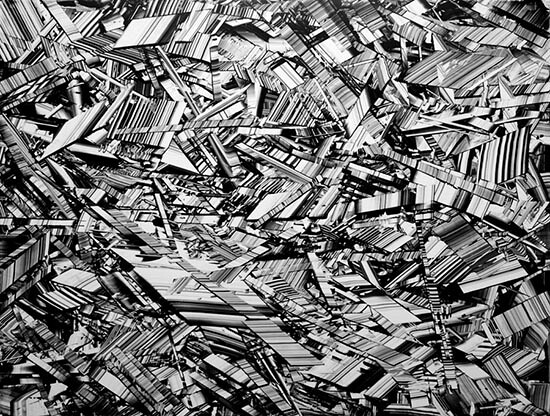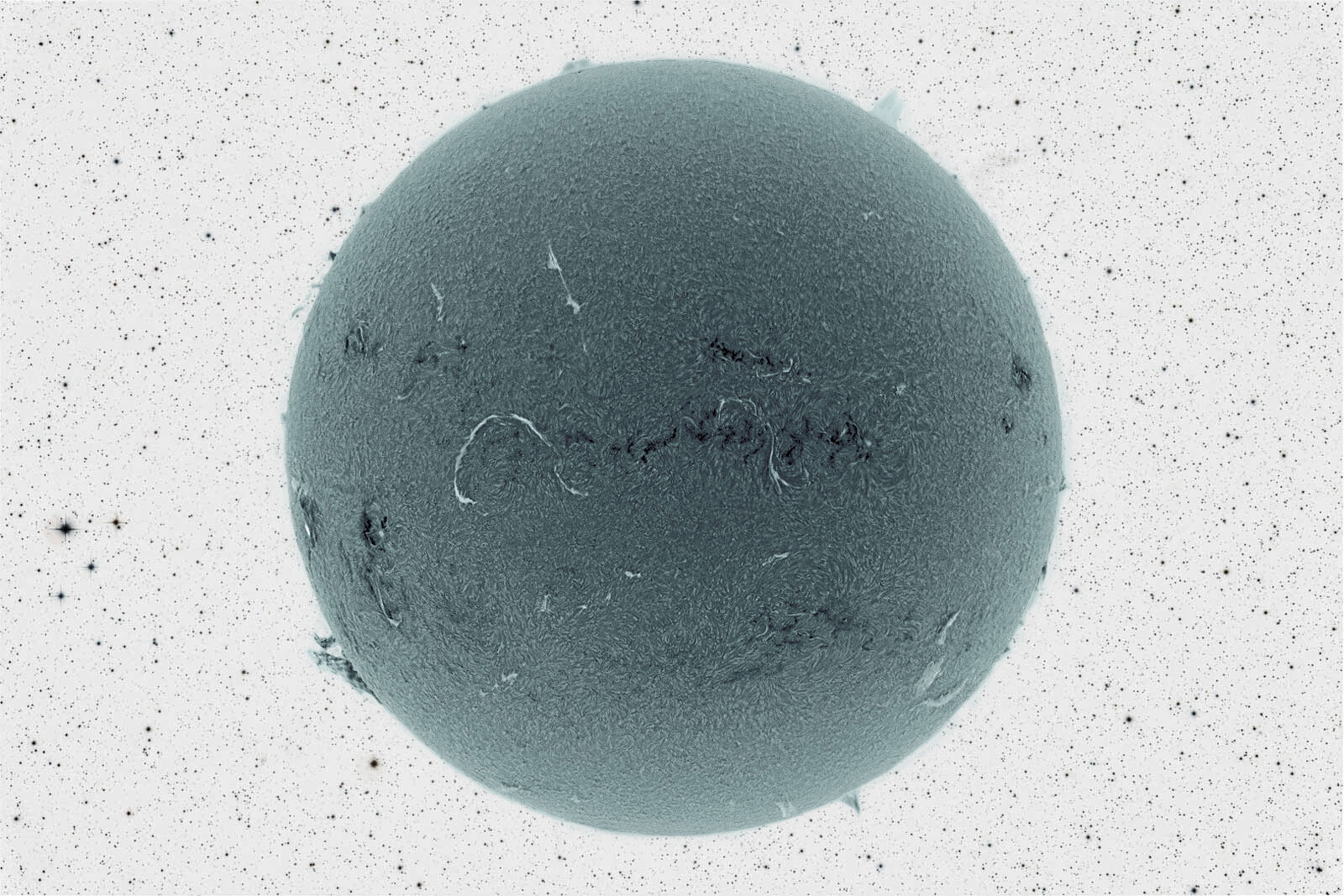The atoms encode. Material elements, they perform as well as signs; they inform each other mutually, elect each other, choose each other, reflect each other, repel each other, like the diamonds in that cave of wonders, like all molecules do, like the codes of the living combine … They encode, we encode; they count, we count; we speak, they speak. Knowledge is thus the ability to listen and to translate the scattered languages of things. They usually speak mathematics.
—Michael Serres, “L’information et la pensée,” 2014
Computing in the Dark
In a recent lecture Michel Serres took the scintillation of darkness as a better archetype of knowledge than the worn-out metaphor of “enlightenment.” The cruelty of daylight abstraction was matched by a serene nocturnal cosmology, in which a multitude of stars displace the Sun King of Western reason from the throne it has been occupying since the 1700s.
More beautiful than the day, peaceful by all means, the star-studded, pensive and soft night is a better model of knowledge than the sun-struck, cruel, exclusive, eye-hurting, ideologically-prone and opinion-ridden light of day.1
Also contesting Plato’s cave—the canonical allegory that repeatedly sings only “the glory of one sun”—Serres found a prismatic grotto in Jules Verne’s novel The Star of the South. Following the tradition of plural materialism that has belonged to French philosophy since Gaston Bachelard, Serres descends then into Verne’s underworld to implode “the light of reason” into myriad prisms:
They were in the center of an immense grotto. The ground was covered with fine sand bespangled with gold. The vault was as high as that of a Gothic cathedral, and stretched away out of sight into the distant darkness. The walls were covered with stalactites of varied hue and wondrous richness … The decomposition of the luminous rays by the thousands of prisms, the showers of brilliancy that flashed and flowed from every side, produced the most astonishing combination of light and color that had ever dazzled the eyes of man.2
How does this acephalous web of flickering rays reflect the contemporary technosphere? In the opening quote of this text, Serres ambitiously attempts to unify ancient atomism and modern computation in a gentle version of Leibniz’s mathesis universalis. Serres conflates the different dimensions of energy, light, information, and knowledge into the figure of a cosmic computer with no central algorithm: neither a central sun nor a central human is directing it. 3 Such a cosmology is clearly responding today to a historical juncture: sensing the current technical composition (i.e., the acceleration of intelligent machines), Serres probably aims at bringing atomism to a computational level (recognizing the license of computation also to nature) and, simultaneously, at dispersing computation into the infinite universe (depriving therefore the Turing technosphere of its epistemic and political hegemony). This computationalism is a new version of atomism rather than vitalism. Pancomputationalism (the idea that everything computes) must be distinguished from the fashionable doctrine of panpsychism (the idea that everything “thinks”). From cybernetics to neuroscience, from philosophy to physics, the idea of computing appears to be used more and more often today to challenge and secularize the conceptual hegemony of both the living and the thinking. Computation emerges as the profane ground that aims to unify the two traditionally separated domains of res extensa and res cogitans, the sciences of nature and the sciences of spirit.
Curiously, despite his critique of enlightenment, for Serres the medium of universal computation is once again light—that still wears, like the god Hermes, the winged shoes of the “third messenger” between matter and cognition.4To rethink a politics and aesthetics of shininess, it would be interesting one day to reverse this correlation. Will darkness ever have its own medium of communication? Will it ever be possible to envision a medium that operates via negation, abduction, absence, the void, and the non-luminous? Is the darkness able to compute?


The Ultimate Capital is a Databank
The first to suggest that the cosmos may be a calculator was the Berlin-born engineer Konrad Zuse, pioneer of modern computer and programming languages, in his 1969 book Calculating Space. 5 For Zuse, the entire universe could be described as the output of a deterministic computation of a single cellular automaton.6 Half a century later, on the other hand, Serres’s universe still resembles, curiously, just the very basic information channel articulated by Shannon and Weaver’s model, with no account of the progress made in cognitive sciences, artificial intelligence, and machine learning: “Bacteria, fungus, whale, sequoia, we do not know any life of which we cannot say that it emits information, receives it, stores it, and processes it. Four universal rules, so unanimous.”7 Also trees compute, adds Serres, as they “calculate” each year in the rings of their trunks. We may like the idea that the whole of the universe computes and scintillates, that forests calculate, that mushrooms keep on extending the earth’s natural internet, yet in which way can these cosmologies provide a basic grammar of ecology and economy that is useful to explain the crucial phenomena of surplus, capitalization, crisis, and transformation?


In his 1980 book The Parasite, Serres took the sun as the symbolic form of capital par excellence: “The ultimate capital is the sun,” he wrote, retracing the history of ancient solar cults and their philosophical reincarnations. The political economy of the solar system, namely the coupling of terrestrial photosynthesis with sunlight, was probably introduced into French philosophy by Georges Bataille.8 Unlike Bataille and his idea of sacrificial expenditure, Serres related the metabolic accumulation of solar energy also to the tendency of terrestrial capitalism towards abstraction. Serres’s idea of energy also included the dimension of language and the progressively abstract flows of money, signs, and data: not just the transformation of energy into money and money into signs, but also the transformation of information into data and the rise of “data banks.”9 Serres was writing in 1980 and such a form of capitalization—the accumulation of information on information—can be properly understood only today, in the age of the metadata society and the global data centers of Google, Facebook, and the NSA.10
What is capital? It is the reservoir above the dam, an iron mine or a coal, manganese, or tungsten mine; a gold mine. An oil well. It is a stock of energy and of primary material; it is an island of negative entropy. It is a store of writings. The old standard of precious metal, having become banal, tends to disappear. We are moving toward a data bank. These reservoirs are only subsuns. Their source, far upstream, is the sun. The real, ultimate capital is the sun.11
In the same passage, Serres criticizes Bataille’s philosophy of excess as just another “subcult of the sun” that still falls within the conventional worship of our regional star. Indeed, Bataille belongs to the canon of modern philosophy and its intrinsic heliocentrism, or the idea that the sun (clearly a doppelgänger of capital, according to Serres) is the center of all worldly affairs.12Whereas Bataille was providing a model of surplus value (albeit a vitalistic one), Serres appears to be in fact a materialist philosopher without a model of surplus value and accumulation—that is, a basic grammar of transformation. Serres’s figure of the parasite was an attempt to replace Marx’s notion of surplus value with a different ethical profile to cover both the domains of ecology and economy, but still it remained on the same level and scale of the agents that it was supposed to parasite. Curiously, the diagram of the parasite sketched by Serres in 1980 was still drawn according to Shannon and Weaver’s model of sender → message → receiver. In French, the word “parasite” also means the noise of static electricity in an information channel such as a telephone wire: Serres’s parasite is also the grandchild of the second law of thermodynamics, or the law of entropy. Nevertheless, by stressing the parasitic metabolism of data and computation, Serres critiques some current forms of pedestrian neomaterialism and not just Bataille’s vitalism.
Exogenesis of Light
How does energy eventually turn into information, and information into capital? How do these domains speak to each other? And, more importantly, how can we register forms and degrees of accumulation and surplus across the different levels of computation? With whatever neomaterialist and neorationalist philosophy has to confront the issue. The scale of current planetary computation inaugurates a new epistemic space that changes permanently Serres’s old atomistic coordinates and informational metaphors. From climate change to financial trading, from “dataveillance” to logistics, everything is computed across an infinite datascape encaged in the data centers owned by media monopolies. Mass computation is a form of power and capitalization that today sits alongside the traditional forms of economic, military, and political power; it comes to constitute a new hybrid imperial nomos.13
It is only via a planetary scale of computation that climate change, the Anthropocene paradigm, and even the Gaia hypothesis can be described, as Paul Edwards has shown in the fundamental book A Vast Machine.14 The planetary network of climate science institutions incarnates a centralized form of computation that questions also the political autonomy of the ecological paradigm. The “solar databases” described by Serres in 1980 are here reversed: they do not measure and condense solar value, but they compute and politically contain the energy surplus of the earth.15
The idea that living metabolism is based on the accumulation of energy against entropy (or negentropy) has been recently contested by new theories. Jeremy England at MIT has proposed new mathematical formulas to suggest that the evolution of complex organisms and species may actually function to dissipate more energy compared to the gradient of irradiation of the inorganic world.16 According to this theory, life emerged on earth under the continuous and excessive irradiation of sunlight: the “pressure” of the sun pushed molecules to form more complex structures in order to channel and disperse energy more efficiently. The multiplication of different species, and evolution itself, was just a more efficient strategy to broadcast energy, not just to accumulate it.


The idea that living matter transmits energy faster and more successfully than the old bricks of the cosmos may be useful for cracking up the old vitalist diagrams in which nature is usually domesticated. Deleuze and Guattari tried to frame life as a line of flight pulled by the outside rather than as a drive pushed by an internal force. In their ontology, exogenesis replaces the old model of endogenesis. This is why the concept of deterritorialization comes logically before territorialization in their history of capitalist evolution. It is the outside that generates and drives the system, and not simply the organism that projects and inhabits its own Umwelt (like in the German Naturphilosophie). What is fascinating in England’s hypothesis is that even the human mind and its form of extended cognition can be seen as extensions of this quest towards more complex architectures of energy. In this view, nature is not simply an organism that emits, receives, stores, and processes information: energy and light shape this very living matter from the outside, and they innervate it so it can multiply exponentially. It is fatalism to leave this idea of overgrowth and irradiating complexity solely to the description of solar capitalism. Politics and aesthetics have to be part of this quest towards more complex architectures of light.
Michel Serres, “L’information et la pensée,” keynote lecture, Philosophy After Nature conference, Utrecht, September 3, 2014.
Jules Verne, “The Star of the South,” in Works of Jules Verne, vol. 13, ed. and trans. Charles Horne (New York: Tyler Daniels, 1911), 276–77.
See his earlier work on Lucretius’s atomism: Michel Serres, La naissance de le physique dans le texte de Lucrèce (Paris: Editions de Minuit, 1977). English translation: The Birth of Physics (Manchester: Clinamen Press, 2000).
On the role of the “third messenger” in Serres’s epistemology see Michel Serres, Hermes: Literature, Science and Philosophy (Baltimore: Johns Hopkins University Press, 1982).
Konrad Zuse, Rechnender Raum (Braunschweig: Friedrich Vieweg & Sohn, 1969). English translation: Calculating Space (Cambridge, MA: MIT Press, 1970).
See the painting Zuse made that was inspired by this idea →.
Serres, “L’information et la pensée.”
Contra Bataille, apparently the cult of the sun god in ancient Egypt was born after the introduction of the calendar. The abstraction of space (geometry) was introduced to govern the agricultural fields on the Nile delta. The abstraction of time (the calendar) was introduced to govern and organize agricultural seasons. The cult of the sun emerged then not because of a metabolic worship.
The expression “data bank” was used in Romance languages more often than in English. It suggests a relation between data and capital that disappears in the term “database.”
See Matteo Pasquinelli, “Italian Operaismo and the Information Machine,” Theory, Culture & Society, vol. 32.3 (2015): 49–68.
Michel Serres, Le Parasite (Paris: Grasse, 1980). English translation: The Parasite (Baltimore: Johns Hopkins University Press, 1982), 173.
For a critique of “heliocentric slavery” see also Reza Negarestani, “Solar Inferno and The Earthbound Abyss,” in Our Sun, ed. Pamela Rosenkranz (Rome: Istituto Svizzero, 2010).
See Benjamin Bratton and the idea of the Black Stack in e-flux journal 53 (March 2014) →.
Paul Edwards, A Vast Machine: Computer Models, Climate Data and the Politics of Global Warming (Cambridge, MA: MIT Press, 2010).
Technically, solar databases provide measurements of sunlight exposure for almost any area of the world. See the Open Solar Database →.
See Natalie Wolchover, “A New Physics Theory of Life,” Quanta Magazine, January 22, 2014. The idea of dissipative structure was originally suggested by the Nobel Prize winner Ilya Prigogine in Self-Organization in Non-Equilibrium Systems (New York: Wiley, 1977).






